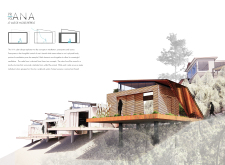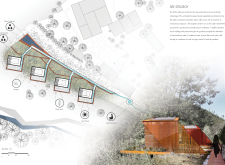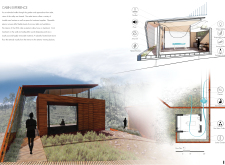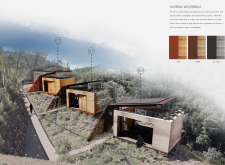5 key facts about this project
The PRANA Cabin project is situated in the tranquil environment of Vale de Moisés, designed as a retreat space promoting meditation and mindfulness. This architecture integrates conceptual elements of pranayama and asana, emphasizing breath control and bodily posture. The project functions primarily as a personal retreat, offering solitary spaces for meditation and contemplation. It is part of a collection of cabins that extend the retreat’s offerings, providing intimate settings that foster mental and physical rejuvenation.
The architectural design is characterized by a robust outer structure resembling a protective shell. The careful placement of these cabins creates a dialog with nature, encouraging users to engage in introspective practices while surrounded by the calming effects of the landscape. Key elements include large operable screens that modulate light and privacy, flexible interior spaces accommodating various yoga and meditation practices, and an overall orientation that considers natural light and airflow.
Unique Design Approaches
One distinguishing feature of the PRANA Cabin is its commitment to sustainability through material choice and adaptive reuse. The use of black locust wood not only ensures structural integrity but also aligns with ecological considerations due to its rapid renewability. The incorporation of corten steel is notable for its aesthetic and functional properties, as it naturally weathers to harmonize with the environment over time. Local stone tiles on the flooring provide durability while rooting the design in the geographical context of the Vale de Moisés location.
Another unique aspect of the project is its integration of water management strategies. A channel designed from corten steel facilitates the flow of rainwater while simultaneously acting as a path that connects different cabins and gardens. This design fosters a relationship between the built environment and natural water cycles, promoting sustainability and enhancing user experience.
Attention to user experience is evident in the layout and spatial dynamics throughout the cabins. Spaces are configured to allow for a variety of meditation and relaxation methods, enhanced by large windows that provide uninterrupted views of the landscape. Acoustic treatments contribute to a serene atmosphere, supporting the primary function of the cabins as spaces for mental clarity and relaxation.
Exploring the architectural plans, sections, and design elements of the PRANA Cabin reveals a thoughtful balance between functionality and aesthetic appeal. For those interested in architectural ideas that prioritize wellness and sustainability, a deeper investigation into the project presentation will provide further insights into its design methodology and applications.





















































